Edinburgh Fruit Scones are an old-fashioned Scottish bake that originates in the beautiful capital city of Scotland: Edinburgh. Soft, crumbly, and sweetened with delicious dried currants these scones are perfect to enjoy with a nice cuppa tea. These scones are naturally egg-free and can be easily prepared as vegan-friendly by using dairy-free milk. For an added fat-free scone you can replace the margarine with mashed banana. We have tested this variation and the banana gives the scones a lovely banana flavour and slightly alters the texture, but we did enjoy the scones very much.
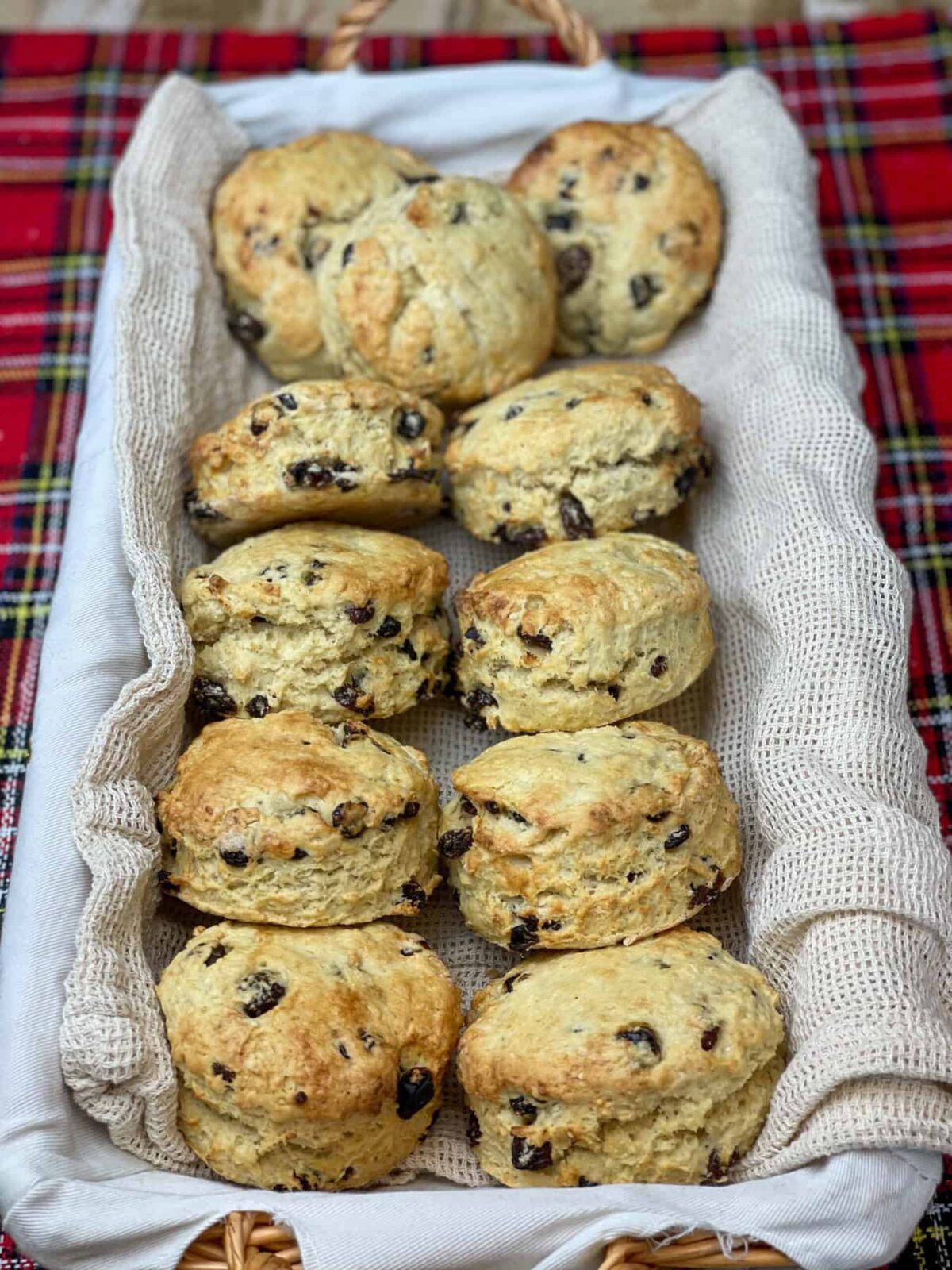
You don't have to be vegan or plant-based to enjoy these traditional Edinburgh Fruit Scones. In fact throughout history the best scones have always been egg-free and replacing butter with a margarine such as Stork baking spread, does result in the lightest, fluffiest and best tasting scone.
Jump to:
💚 Why You’ll Love This Edinburgh Fruit Scones Recipe
- Naturally egg-free & easily vegan-friendly Many traditional scones are eggless, and these bake up beautifully with plant-based milk or your usual milk.
- Simple, wholesome ingredients Made with pantry staples like flour, currants, sugar, and margarine. No fancy equipment needed.
- Quick to prepare Just 15 minutes of prep and under 15 minutes in the oven.
- Perfect texture Light, soft, crumbly, and not overly sweet just as a good scone should be.
- Versatile Enjoy plain, with jam and spread, or go all-out with cream and afternoon tea. Or enjoy for a picnic with cheese and tomatoes.
- Make ahead & freeze Great for batch baking and storing for busy days or special occasions.
- Historic & homey Inspired by Edinburgh’s traditional bakes and cosy Scottish teatimes.
💬 What Readers Are Saying! 💬
- “This is a Fantastic recipe. Super EASY and yet so very Tasty. I've made it 3 times in the past week, and everyone's asking me for your recipe.” 💬
- “We had these Christmas morning while opening presents. They are delicious. We’ve been vegan for many years and I’m very glad to have found your recipes.” 💬
- “Great with morning coffee. Super quick and easy to make – very tasty.” 💬
- “Enjoyed these for breakfast this morning and started the day off right! Easy, delicious and paired perfectly with my morning cup of coffee!” 💬
- “These are so delicious spread with an orange marmalade puree. We loved them and will make them often!” 💬
Origin of Scones
If you would like to find out about the origins of scones and afternoon tea then click the toggle '📜'below. We have tidied the food history away for those who prefer to get straight to the recipe!
📜 Origin of Scones
Scones have a long history, evolving from a flat quick bread that cooked on an open griddle during the 1500s in Scotland. This type of flat bread, known as a bannock, was a no-yeast bread prepared with ingredients such as barley flour, oats, sometimes wheat flour, water, and some kind of fat. Many modern recipes for bannock are flavoured with dried fruit such as raisins, dried currants, or sultanas and these bannocks are like a large, flatter scone, served just like a scone but divided into triangles. Some believe that the scone is named after the Scottish Stone of Destiny, also known as the Stone of Scone. This sacred stone was where Scottish kings of old were coronated and officially made kings.
The practice of eating scones for afternoon tea is said to have begun with the Duchess of Bedford, England, during the 1800s. The duchess felt hungry at 4 p.m., so the servants brought her sweetbreads and scones along with her usual cup of tea. This afternoon treat with tea and scones became a daily event, and so, the English tradition of afternoon tea was born.
Scones received a literal boost when baking powder was invented by Alfred Bird in 1843, which allowed scones to rise, becoming softer and lighter.
Growing up in Scotland, afternoon tea was not an actual occurrence in our family, and I was unaware of its existence. However, somehow the practice has now become part of my own family tradition, which my older kids especially love. Who doesn't enjoy a cup of tea or coffee with a freshly home-baked scone straight from the oven? I also love the TV shows Downton Abbey and Call The Midwife, especially because I enjoy seeing their afternoon tea, dinner, or tea time spreads, and I get particularly excited whenever a scone is shown! I am easily amused!
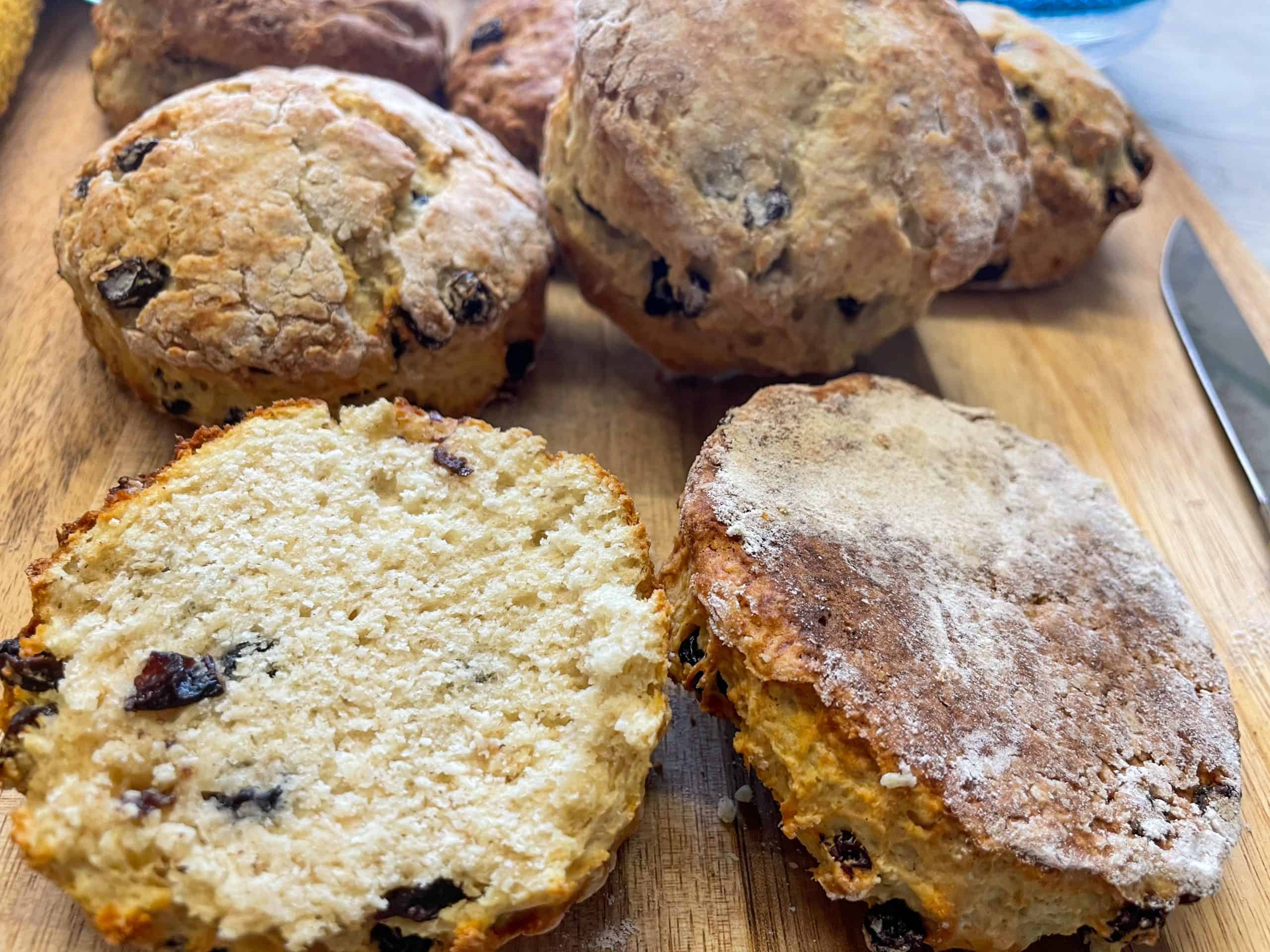
These egg-free fruit scones rise beautifully, are light, soft, and especially delicious when enjoyed warm from the oven
Edinburgh Fruit Scones
I lived in Edinburgh for many years with my kids and loved all the wee bakeries and cafes that showed off all the wonderful Scottish Old Town bakes. However, back then, vegan options were few and far between. But on more recent visits, there are thankfully many vegan options in Edinburgh to enjoy.
Although a good traditional vegan scone can be difficult to source, so I have adapted a tasty vintage Edinburgh scone recipe. This recipe results in a satisfying, rustic-looking scone that is soft, light, crumbly, not too sweet, and perfect with some spread and a slather of fruit jam.
If you're feeling fancy, add some thick cream and enjoy it with a cup of tea for a Scottish afternoon tea experience. But don't forget the cucumber sandwiches, and stick your pinkies out when you're drinking your tea as that's considered the height of politeness! Oh, and add a slice of this Vegan Victoria Sponge Cake, and now you've got a proper afternoon tea!
Historically, scones have been baked without eggs, making them naturally suited for egg-free diets. Our family recipe continues this tradition, making it ideal not only for vegans but also for those who require egg-free or dairy-free options, or even just for those who love good home-baking as honestly no-one will know the difference.
However, if you have different dietary requirements then you can use any type of milk that you normally use as this recipe will work fine with any milk.
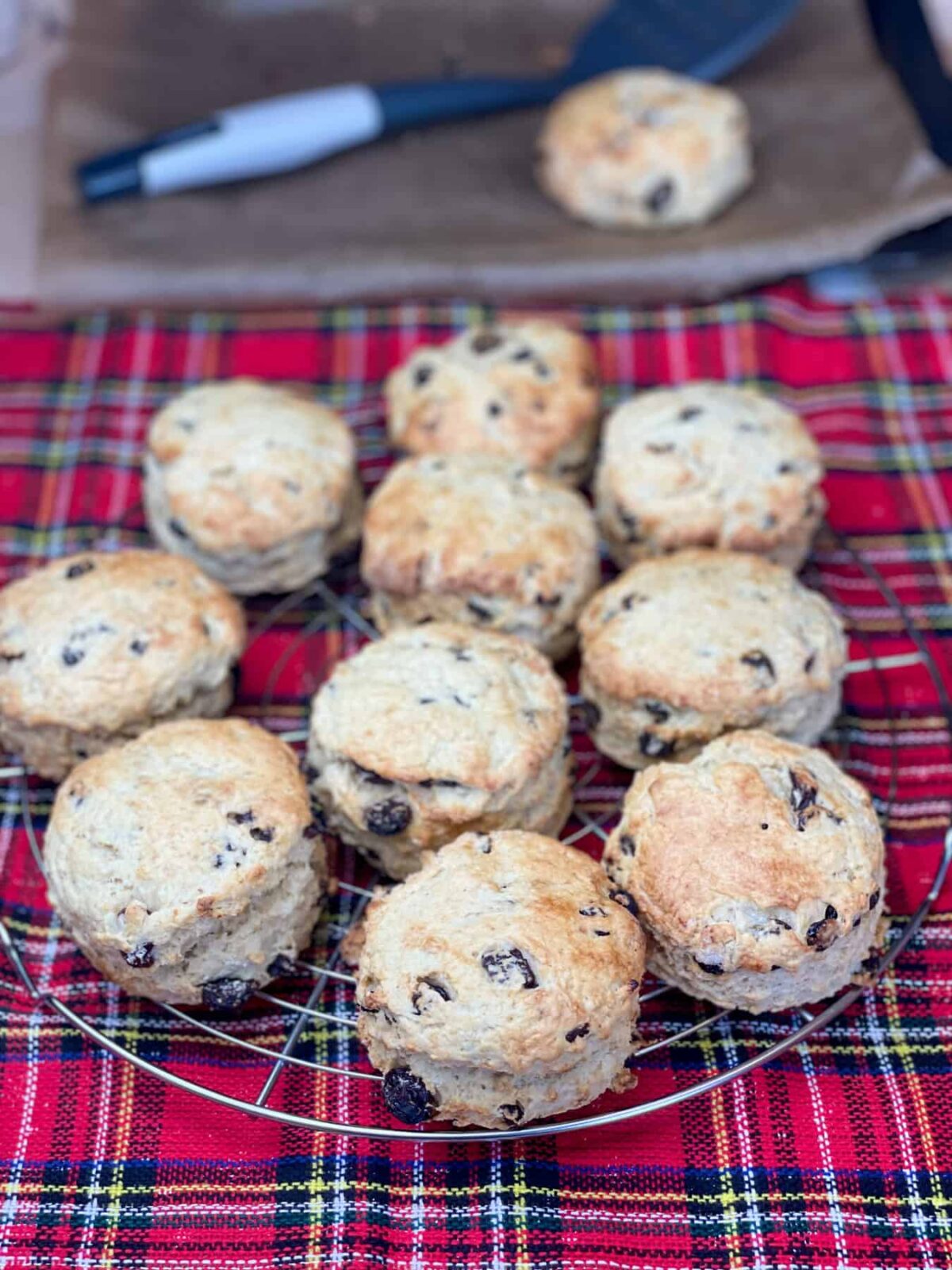
How to prepare
Just like many traditional scone recipes these fruit scones use buttermilk as this adds to the rise as well as the scones deliciously soft & crumby texture. As we are a plant-based family we used soya milk for the home-made buttermilk but of course you can use your usual milk instead.
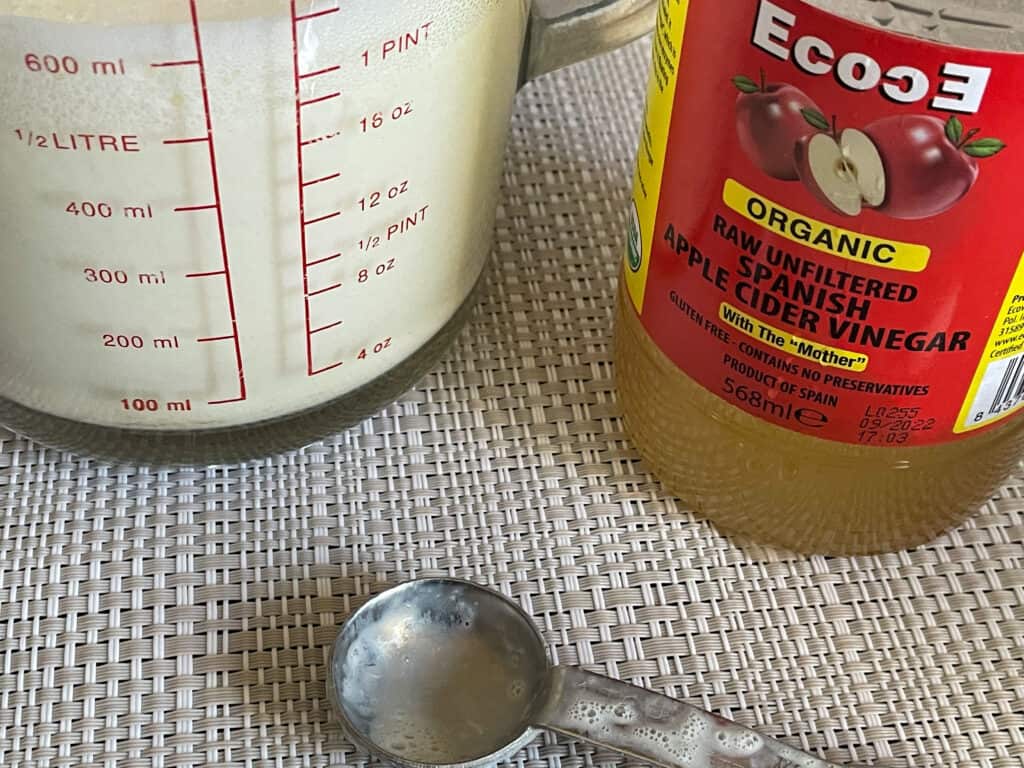
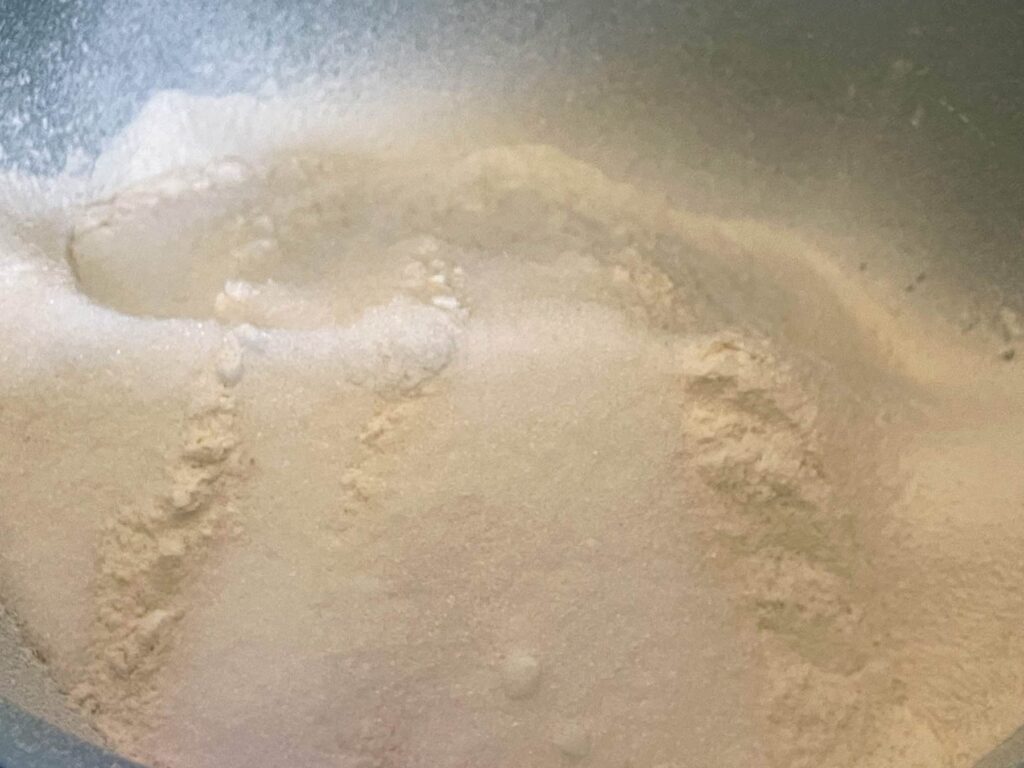
Step 1: Prepare the buttermilk by mixing milk and apple cider vinegar or lemon juice in a jug. Leave it to sit and curdle for about 15 minutes.
Step 2: Sieve the flour and baking powder into a bowl.
Step 3: Mix through the sugar and salt.
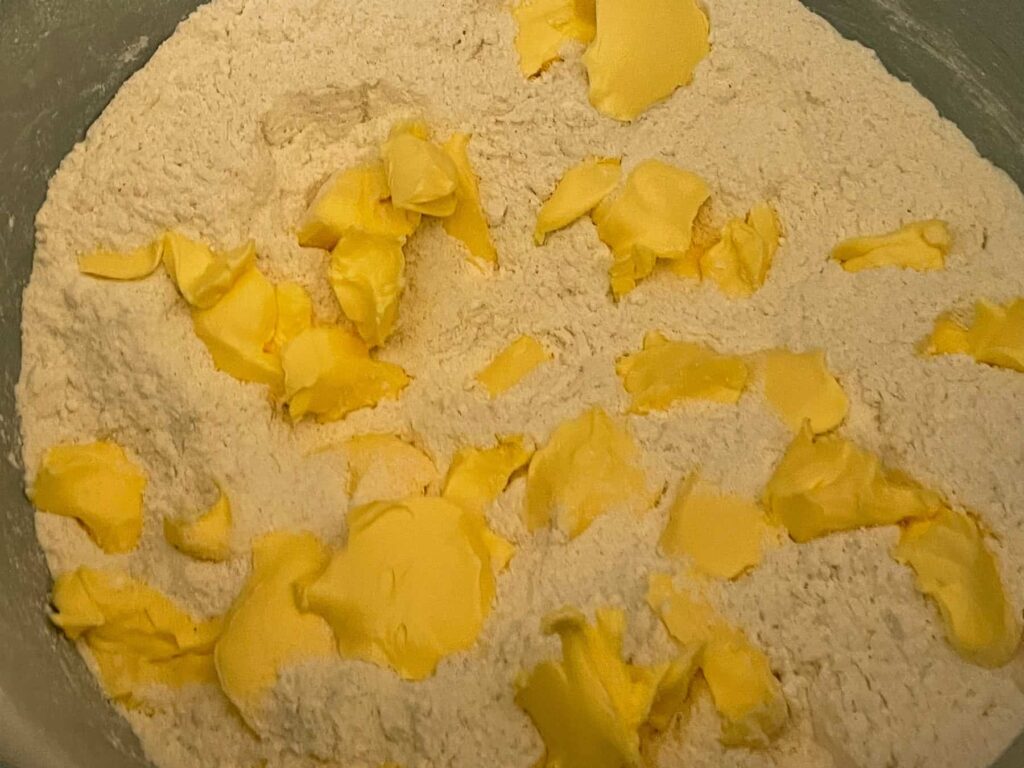
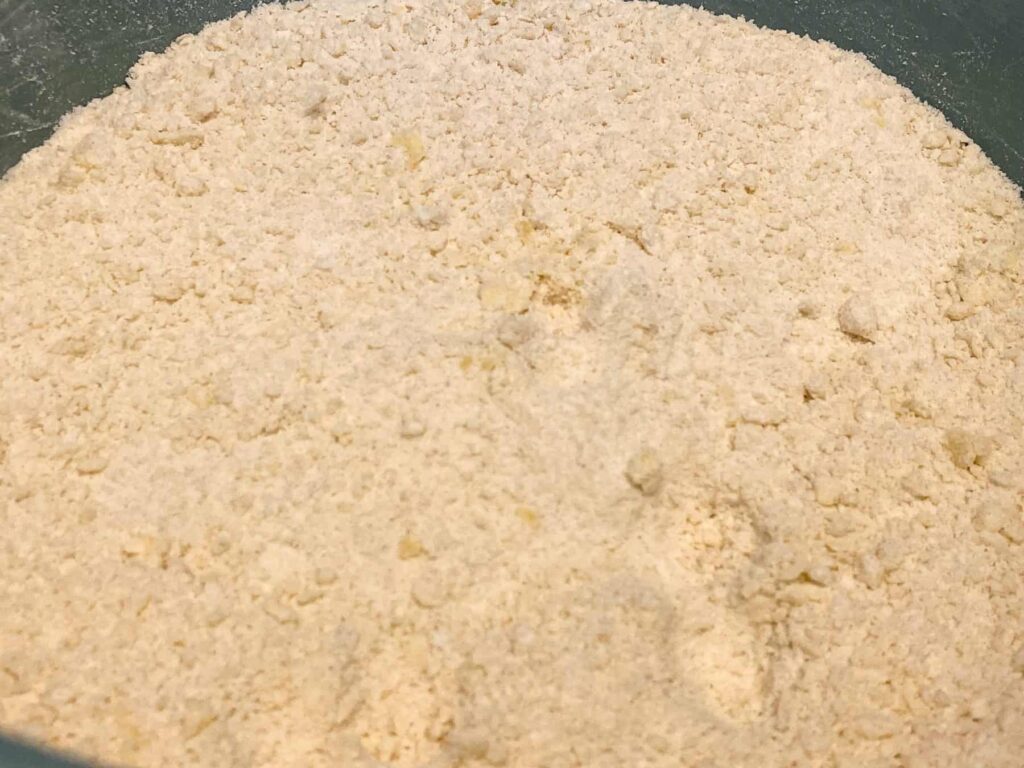
Step 4: Add small bits of margarine to the flour mix.
Step 5: Using your finger tips rub the margarine into the flour mixture until it resembles bread crumbs.
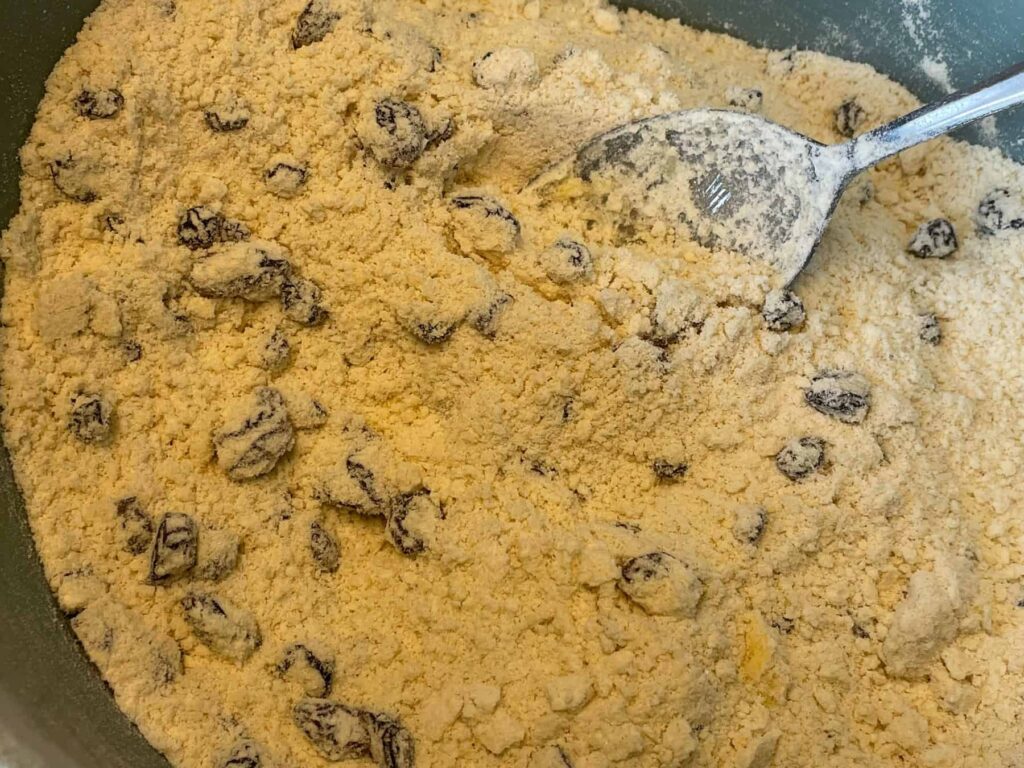
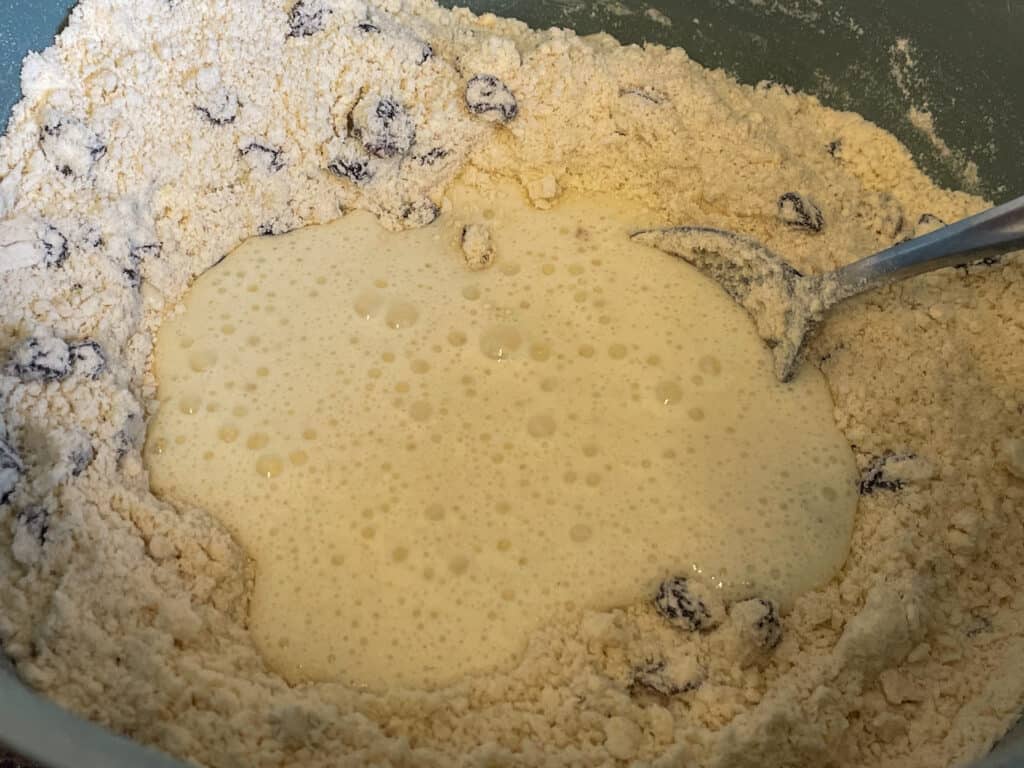
Step 6: Mix through the dried currants.
Step 7: Add tablespoons of the buttermilk at a time and use a metal spoon or cutlery knife to mix the milk in.
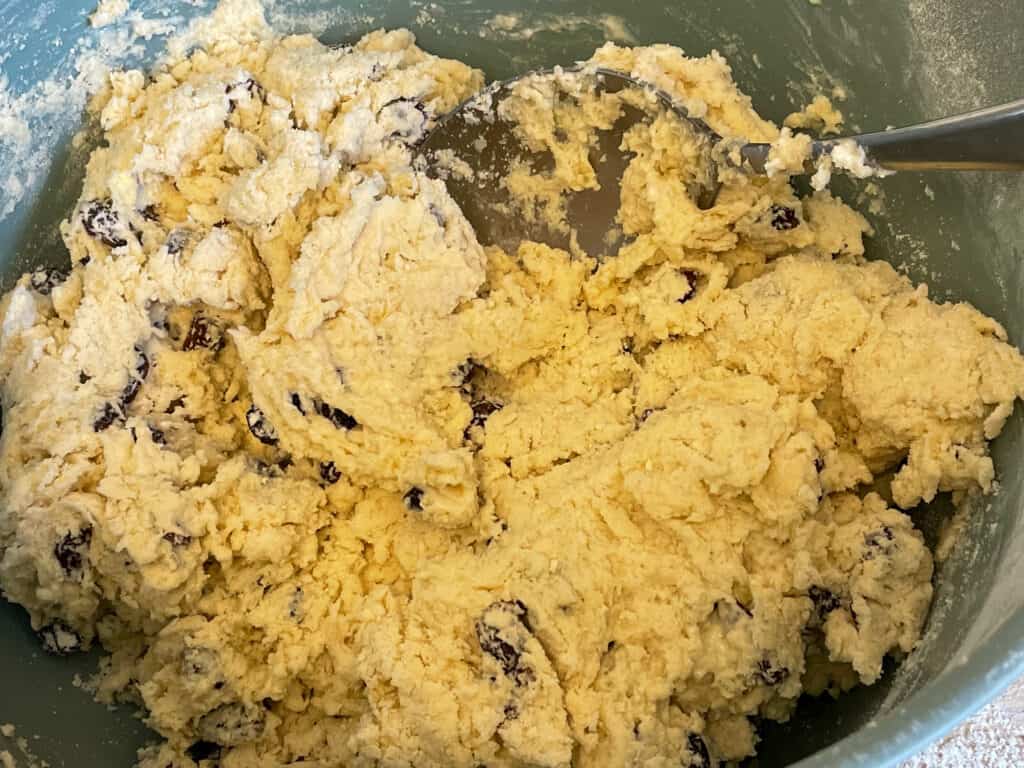
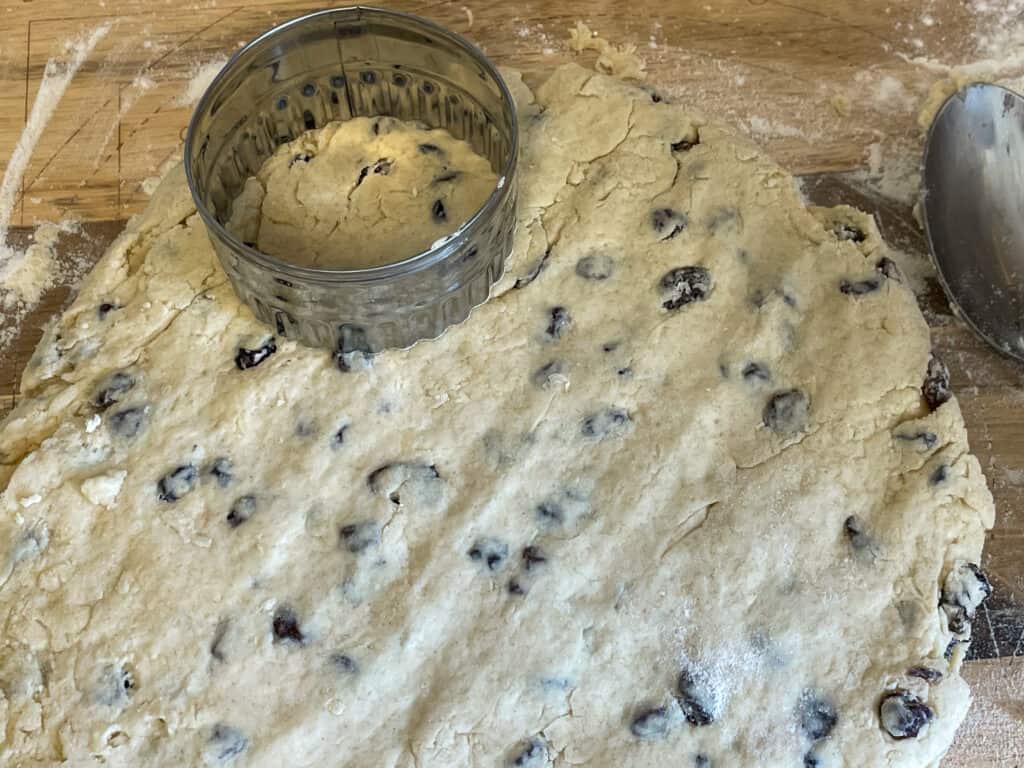
Step 8: Use just enough buttermilk to form a dough.
Step 9: With your hands bring the dough together.
Step 10: Sprinkle flour over your work surface.
Step 11: Pat the dough down with your hands and use a biscuit/cookie cutter to gently stamp out six scones.
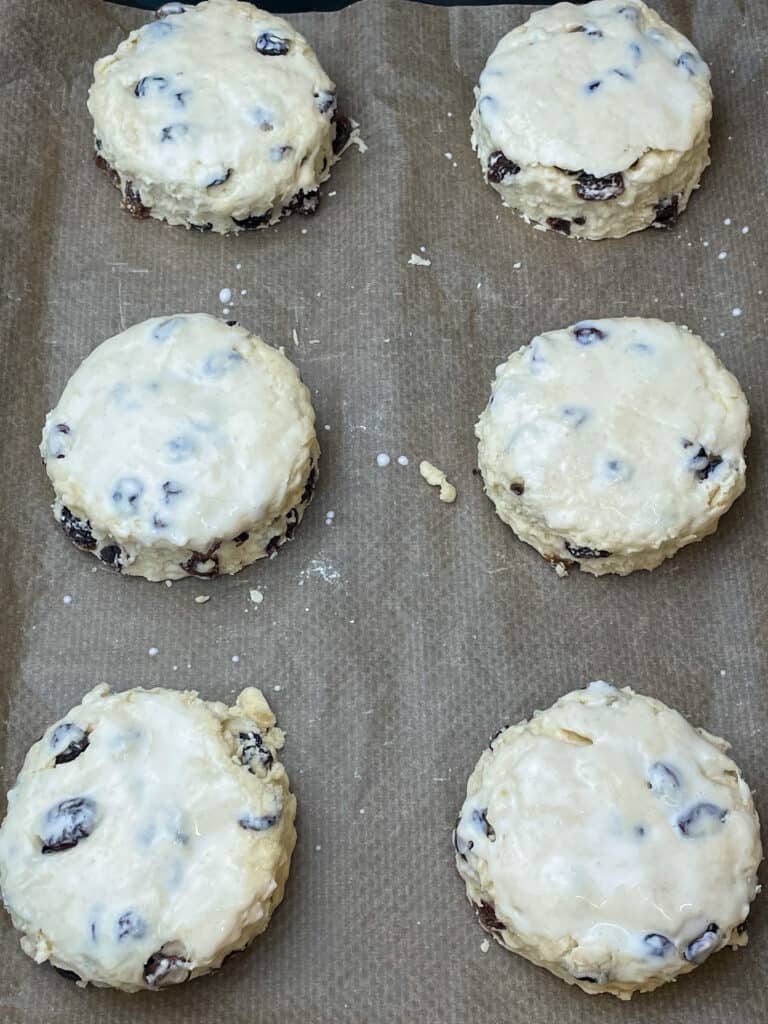
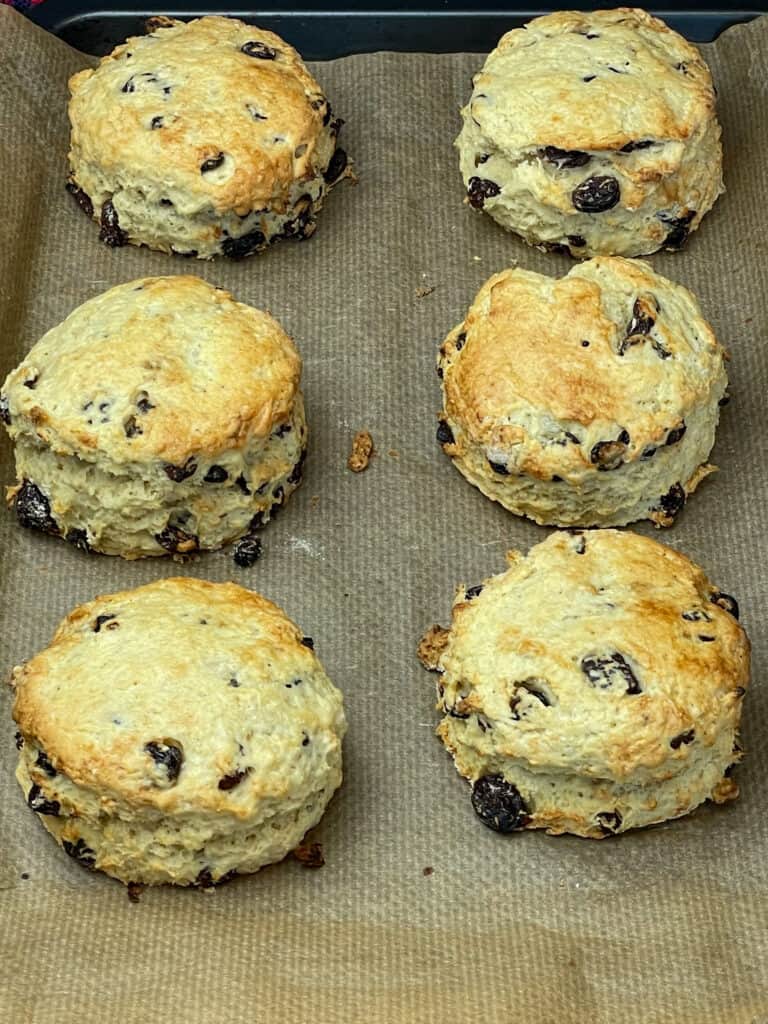
Step 12: Place on a baking tray and brush the tops with leftover buttermilk.
Step 13: Bake in a hot oven until lightly golden and risen. The aromas will be amazing.
Step 14: Leave on the baking tray for 5 minutes before setting on a cooling rack to cool.
***please note: for US measurements click the 'US customary button' within the recipe and the measurements will switch to tablespoons, cups, and ounces.***
📖 Recipe
Edinburgh Fruit Scones
Equipment
- Measuring jug
- mixing spoon
- sieve
- Mixing bowl
- cutlery knife or spoon
- Baking tray plus parchment paper to line
- Biscuit/cookie cutter about 7cm diameter
Ingredients
For the buttermilk
- 250 millilitres milk [we use soya or oat milk but any milk will do so you can use your usual milk, use extra if required]
- 1 teaspoon apple cider vinegar [or white distilled vinegar, or lemon juice]
Basic scone recipe
- 285 grams self-raising flour [plus extra as required]
- 2 teaspoons baking powder
- 2 tablespoons caster sugar [or granulated]
- 57 grams margarine [use one suitable for baking, we used Stork baking spread]
- 1 pinch salt
- 110 grams dried currants [dried currants are the traditional choice, but dried raisins, sultanas, cranberries or mixed dried fruit can be used]
Instructions
- Preheat the oven to 200°C Fan / 220°C / 428°F / Gas Mark 7.
Prepare the buttermilk:
- Add the apple cider vinegar or lemon juice to the milk and mix well. Set aside until needed or leave to sit for at least 15 minutes.1 teaspoon apple cider vinegar, 250 millilitres milk
Prepare the scones:
- Sift the flour and baking powder into a mixing bowl.285 grams self-raising flour, 2 teaspoons baking powder
- Stir through the sugar and salt.2 tablespoons caster sugar, 1 pinch salt
- Add in the margarine and using your fingertips rub the margarine into the flour until the mix looks like breadcrumbs.57 grams margarine
- Mix through the dried currants.110 grams dried currants
- Add a tablespoon of buttermilk at a time to the scone mixture, stirring well with a cutlery knife or similar.You may need between 8-10 tablespoons to achieve a dough.
- Once a dough has nearly formed tip the dough onto a floured surface and gently work it together to a ball. It may be slightly sticky but that's ok, just sprinkle extra flour over it.If it's too dry and crumbly wet your hands with a little of the leftover buttermilk and try form the dough ball. Or sprinkle some milk over the dough and work it into a ball.
- Gently pat the dough into a thick circular shape. For large scones pat down until the dough is about 1 inch high [2 ½ cm].For smaller scones pat down to about ½ inch thick [1½ cm].Measurements are just rough estimates so don't get too bogged down trying to achieve perfection!
- Dust the biscuit cutter with some flour, and gently stamp out scones being careful not to twist the cutter as you remove the scone, as this may result in a wonky rising scone. Although wonky rising scones are traditional and just as good!
- If you want taller scones then they will have to be quite tall going into the oven.
- Place the scones onto a floured baking tray or use parchment paper if necessary to prevent sticking.
- Lightly glaze the top of your scones with the leftover buttermilk. If you don't have much buttermilk left just use the drips or remnants left on the sides of your jug. A pastry brush is helpful here! But clean finger tips can also do the job!If you don't have enough buttermilk just use some milk.
- Bake on the middle shelf or one shelf under your highest shelf, for about 10-14 minutes. We used a fan oven so our smaller scones generally take around 10 minutes and larger scones about 12-13 minutes. Although as fan ovens tend to bake faster other ovens may take a few minutes longer.
- Scones will be ready when they smell lovely, have risen, are lightly golden brown and browned on the underside as well.
- Enjoy warm from the oven or once removed from the oven leave the scones to sit on the tray for 5 minutes before removing to cool on a cooling rack.
Notes
- Nutritional data is for guidance only and is not intended to be an exact calculation as ingredients vary.
- It's generally advised that fruit scones are best eaten the day they are baked. However I find that the flavour and texture of the scone can be better the next day. Scones will be good for up to 3-4 days.
- For staler scones just toast and spread with butter or margarine or re-heat in a hot oven for a few minutes and they will be as good as new.
- Scones cope well with being frozen for up to 2-3 months but possibly longer if well wrapped.
- Add any variety of dried fruit to your scones. Such as just sultanas or raisins. Or use a dried fruit mix such as the ones intended for Christmas cakes and puddings. Traditional Edinburgh scones would have used dried currants.
- Don't like dried fruit? You can omit and maybe add some grated lemon or orange zest for a citrusy scone.
- Love cherry scones? Add some chopped glacé [candied] cherries in place of the dried fruit.
- Edinburgh fruit scones are tasty for breakfast, mid-morning snack, afternoon tea or supper. Or anytime you fancy one.
- Fruit scones can be served with a wedge of cheese on the side for a rustic vintage lunch or snack. Add some grapes or cherry tomatoes. Lovely for a picnic lunch.
- Want to prepare a double batch? Simply double the ingredients, but only use 1 tablespoon of baking powder rather than 4 teaspoons as too much baking powder can affect the flavour.
- For an added fat-free scone you can replace the margarine with mashed banana. We have tested this and the scones have a lovely banana flavour but the texture of the scone is abit different but we still enjoyed them very much. Just use the same amount of banana as required for the margarine/butter and rub the banana into the flour mixture as you would the margarine.
- For a healthier flour you can replace half the self-raising flour with a plain spelt flour which works rather well for scones. We have also tested this recipe with half self-raising flour and half self-raising wholemeal flour and the results were very nice. However, do keep in mind that different types of flour will affect the rise and density of the finished scone.
Nutrition
Frequently asked questions
Your scones will be at their freshest for 1-2 days. But after the 2nd-3rd days your scone will still be perfectly fine but if a little stale then simply stick them back in a warm oven for a few minutes to refresh. Your scone will be as good as newly baked, and any butter or margarine spread over will melt and be delicious. Alternatively, slice and toast your scones, which we love to do for a quick breakfast or for an evening suppertime snack.
If you're in the US you may think that currants are related to the currant berry such as black or red currants. However, currants are actually a variety of small grape known as the Black Corinth grape which is believed to have been introduced to the Mediterranean region over 2,000 years ago. From there, it made its way to the UK and other parts of Europe.
To make dried currants, the grapes are left to dry on the vine or picked and laid out in the sun to dry. Once they have dried, the grapes become smaller and darker in colour, with a sweet and tangy flavour.
In Britain, dried currants have been a staple ingredient in traditional baking for hundreds of years. For example, they are a key ingredient in traditional Christmas pudding, which dates back to the 14th century. They are also used in other classic British desserts such as Eccles cakes, mince pies, Scottish fruit slice, and fruitcakes.
Dried currants can be quite expensive depending on where you live and what stores or shops you have access to, so if for any reason you can't use currants its not a major problem for a recipe as there are a few ideal substitutions. Instead you can use raisins, dried cranberries, chopped dried apricots, chopped dried cherries, dried blueberries, or sultanas. Or go with a dried fruit mix such as the ones that are used for Christmas cake and Christmas pudding.
As we use soya milk we prepare our buttermilk as vegan but of course the following ideas can be used for any type of buttermilk. Leftover buttermilk can be used in so many ways so don't pour it down the sink! Even if you don't have enough for a specific recipe, you can always add more milk and more vinegar or lemon juice to top the leftovers up.
1. Vegan pancakes or waffles: Use your leftover buttermilk in place of regular milk in your favourite pancake or waffle recipe. Our pancake recipe can also be made into waffles, simply use the pancake mixture with your waffle machine. We also have a very nice dairy-free & egg-free Chocolate Chip Pancake recipe that also makes very nice chocolate waffles.
2. Vegan biscuits: Buttermilk is a staple ingredient in classic Southern-style biscuits. Use your leftover buttermilk to make biscuits or for a good alternative try our vegan Buttermilk Scone recipe, which is similar to a US biscuit recipe. These buttermilk scones are just the lightest, fluffiest scones ever.
3. Mashed potatoes: Mix your leftover buttermilk with boiled and mashed potatoes just as you would use plain milk.
4. Irish Soda Bread: Use any leftover buttermilk and put it towards the buttermilk required for this deliciously easy no-knead, no-rising, no-yeast traditional Irish wheaten bread.
5. A glaze: Baking bread, scones, rolls, baps, etc? A buttermilk glaze will enhance their flavour whilst creating a lovely golden top.
The best plant-based milk to use when making vegan buttermilk is a milk that has a higher protein content such as soya milk.
Pro scone making tips
1. Ensure that your margarine or butter is cold before rubbing it into the flour as this helps to create a flaky texture in your scones.
2. Work the scone dough as lightly as possible and take care not to overmix or knead the dough too much as it should only be kneaded for a few seconds to avoid toughening the dough.
3. When adding the buttermilk, do so a tablespoon at a time and use an ordinary cutlery metal knife, or similar, to mix. This helps to incorporate the liquid without overworking the dough.
4. Never use a rolling pin to roll out your scone dough. Just gently pat down with your hands to maintain the lightness of the mixture.
5. When stamping out rounds with a biscuit or cookie cutter, do not twist the cutter as you lift it. Just gently move (shoogle as we say in Scotland!) the cutter up and down and pull away the excess scone mix from outside the cutter if necessary.
6. Dip the cookie cutter in flour between each use to help the scone come out of the cutter with ease.
7. Try not to get the sides of your scone wet with too much milk when you glaze the top.
8. Scones do best when baked in a hot oven for a short time, which helps them rise quickly and become light and fluffy.
While it might seem like a lot to remember, once you have prepared scones a few times, they become much easier to bake. I promise! And they are so worth the extra thought.
More traditional scone recipes - made egg-free & dairy-free
Being a Scottish family we love scones. Scones are a staple food and they are a great alternative to a slice of cake as a scone has less sugar and fat yet are good enough to satisfy any sweet cravings. We like scones for breakfast, brunch, lunch, or suppertime but a scone is particularly nice for afternoon tea or tea-time treat.
A few of our family favourite savoury scones are these Buttermilk Plain Scones and these Old-Fashioned Cheese Scones as they pair really well with our budget-friendly home-made Tomato Soup recipe for lunch.
Our family favourite sweet scones are these classic Old-Fashioned Scottish Treacle Scones which I fondly remember enjoying while growing up in Glasgow in the 80s' and for special afternoon teas such as for Mother's Day, Father's Day, Easter, or Boxing Day these Old-Fashioned Cherry Scones are just the ticket. We also offer an easy method for adapting these scones into tasty cherry Bakewell scones.
Comments
Prepared our Edinburgh Fruit Scones recipe? Do let us know how you got on with the recipe as we love receiving your feedback. It would be wonderful if you would drop us a comment below. Thanks very much! All the best, Jacq x
VINDYA DONAHUE says
This is a Fantastic recipe. Super EASY and yet so very Tasty. I substituted the margarine with coconut butter and coconut cooking oil. I've made it 3 times in the past week, and everyone's asking me for your recipe. simple love it
Jacq says
Thanks Vindya for coming back to comment! I'm so happy everyone is loving the fruit scones. That's interesting about the coconut butter thanks for bringing that to my attention as I have just went on Amazon and ordered a jar! Will be trying the coconut butter with the scone recipe. Thanks so much! Jacq x
Jeff says
We had these Christmas morning while opening presents. They are delicious. We have been vegan for many years and I'm very glad to have found your recipes. Thank you so much!
Jacq says
Your very welcome! Thanks so much for your lovely comment. So glad your family enjoyed the scones especially at such a special moment as Christmas morning. Merry Christmas and a Happy New Year 🙂
Anna says
Great with morning coffee. I tried them last weekend for the first time and getting ready to bake my next batch. Super quick and easy to make - very tastey. I did have to bake them for an extra 4 min - will try raise the temp on the oven this time. Thanks for the recipe.
Jacq says
Your very welcome. So glad you enjoyed the Edinburgh scones. Thanks for letting me know how you got on. Yeah it just depends on your oven as cooking time can vary slightly. I have a fan oven so my scones are ready faster. Speaking of scones I'm just going to prepare another batch for my afternoon coffee! 🙂
Sara Welch says
Enjoyed these for breakfast this morning and started the day off right! Easy, delicious and paired perfectly with my morning cup of coffee!
Jacq says
Awesome! So glad you enjoyed the Edinburgh scones. I love them for breakfast too 🙂
Patty at Spoonabilities says
I can just taste these amazing scones - I'm planning to treat my family this weekend with them! And it's awesome that you have shared this vegan version. Thank you for that!
Jacq says
Lovely! I'm sure your family will love these Edinburgh scones. The scones are surely a bite of Scottish history and culture 🙂
Beth says
Oh wow! My hubby and son absolutely loved this recipe! So delicious and very yummy! Excited to make these again very soon!
Jacq says
Brilliant! So glad your family enjoyed the Edinburgh scones 🙂
Sandhya says
Love Vegan scones with a good strawberry jam. This one looks so delicious, I can't wait to try it.
Jacq says
Great! Have fun baking the Edinburgh scones. Think I am going to bake a batch this morning 🙂
Julie says
These fruit scones look absolutely incredible. I cant wait to try them.
Jacq says
Thanks! I love these wee rustic looking scones. Just how they would be a hundred years ago in a cosy Scottish kitchen with an open fire going:)
Claudia says
These are so delicious spread with an orange marmalade puree we loved them and will make them often!
Jacq says
I totally agree! I love these scones with marmalade. Makes for a delicious breakfast or afternoon tea!
Dannii says
I love a fruit scone, and this vegan version looks delicious. I will definitely be trying it at the weekend.
Jacq says
Brilliant! These scones are perfect for the weekend!
Maria says
This looks so delicious! And I must say this might be the quickest and easiest scones recipe I've ever come across with. Might try it this weekend. Thank you for sharing this!
Jacq says
Great! Your very welcome. Enjoy your scones. Think I will go put a batch on now as just thinking about them is making me hungry!
Allyssa says
Thanks a lot for this amazing recipe! it is very helpful!
Jacq says
Your welcome! Thanks for stopping by my blog!
Kristina Tipps says
My little ones absolutely love these! And I love that they are vegan- which we've been trying to eat much of lately.
Jacq says
Awesome! So glad you enjoyed the scones!